The rose is a perennial flowering plant of the genus Rosa, in the family Rosaceae. A universal symbol of beauty and love, rose bushes are a favorite addition to gardens and landscapes. Loved for its many colors and popular scent, roses make beautiful cut flowers for any occasion.
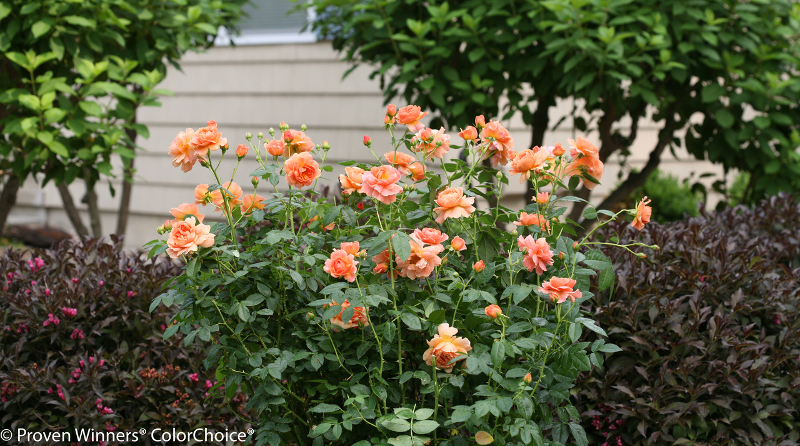
With over three hundred species of roses, you can do a lot with this shrub. Ranging in size from miniature roses to tall climbing roses, there are many uses for roses. Standard roses are perfect for a container grown option. Shrub and bush roses are good for borders and beds. Climbers and ramblers bring color to wall and fence areas. You can purchase rose plants in two forms: bare-root roses or container roses.
-
Bare-root roses - these roses have been grown in the ground and dug up. The roots are wrapped and then sold. This type offers a wide variety of choices and can be ordered online and shipped.
-
Container roses - These roses have been grown in a pot and are usually sold at your local nursery, store, or online.
Roses are one of the easiest shrubs to plant. It can tolerate a range of soil types as long as it is well drained and fertile. Choose an area that gets 6-8 hours of sun each day and your newly planted rose will be happy year after year.
What You Need To Plant Roses
- Shovel or trowel
- Work gloves
- Bone meal or superphosphate
- New rose plant
- Compost (if needed)
- Mulch
- Granular rose fertilizer
Where to Plant Roses
Roses planted in an area that gets six to eight hours of sun each day will produce repeated flowering. A garden area that gets morning sun is good as it will dry out the leaves and help to prevent diseases such as black spot. Planting roses in partial sun will not kill the plant, but will weaken it over time resulting in less blooms. If you are growing roses in an extremely hot climate with minimal moisture, some afternoon shade would be good.
Roses like a more alkaline soil versus acidic soil. A near-neutral pH range of 5.5–7.0 is preferred. Because a rose is a heavy feeder, it also likes rich loamy soil (a sand, silt and clay mixture). If you have poor soil or heavy clay soil, you may want to mix compost into your planting area. It is best to plant roses in soil that has good drainage. Regular deep watering is suggested, but roots left in wet soil will rot. Roses do not like wet cold feet.
Rose Spacing
With so many varieties of roses, spacing depends on the type of rose that you purchase. There is no “one size fits all’ when it comes to spacing. Planted in the most optimal conditions, rose shrubs will grow to reach or exceed its mature size. So, it is better to space the shrubs too far apart rather than struggle with thorny plants that have grown too close together.
When roses bushes are too crowded, air circulation is reduced. This can invite diseases such as blackspot, mildew, and fungus. Oftentimes, roses will need to be pruned. Well spaced bushes allow for a more pleasant pruning experience.

It is best to plant rose shrubs at least three feet away from other plants to avoid competing for the nutrients in the soil. In colder climates, you may want to grow roses near the foundation of a building. The warmth can help to provide winter protection during cold spells. Rose bushes may look small and isolated when first planted, but it will grow and fill your area very fast. It is best to follow the recommended spacing guide on the label of the rose plant you purchase. The below is a general guideline on rose spacing.
- Large shrub roses should be planted 30” to 36” apart. (covers an area of about 6 to 10 square feet)
- Small shrub roses should be planted 24” to 30” apart. (covers an area of about 4 to 6 square feet)
- Hedge roses should be planted 24” apart. (covers an area of about 4 square feet)
- Miniature roses should be planted 12” to 18” apart. (covers an area of about 1 to 2 square feet)
- Climbing roses should be planted 4 to 5 feet apart.
- Standard tree roses should be planted 3 to 5 feet apart.
- Patio tree roses should be planted 3 to 4 feet apart.
- Miniature tree roses should be planted 2 to 3 feet apart.
Steps To Plant Roses
Roses thrive when planted in a garden area with fertile soil, good drainage, and 6-8 hours of full sun each day. Begin by digging a hole 12-18 inches deep and wide enough so the roots can be spread out without touching the sides of the hole. Mix a slow release fertilizer and some bone meal into the soil. Center the main cane of the plant in the hole, allowing the bud union to sit on a mound of soil. Spread the roots out and fill the hole halfway with soil.
Water well to eliminate air pockets and allow the soil to settle. Fill the remainder of the hole with soil and water thoroughly. Sprinkle ¼ to ½ cup of Epsom salts around the base of the plant to help promote foliar and cane development.
Throughout the growing season, the soil should be kept evenly moist, but not so much that it drowns the plant. The general rule is one inch of deep watering per week. Applying a 2-3 inch layer of mulch will help to maintain the moisture level.
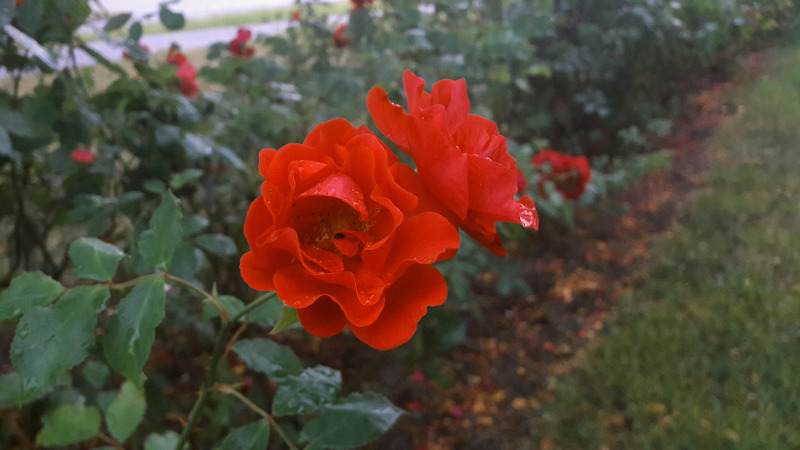
Planting Bare-Root Roses
Step 1 - Remove the packaging and soak the roots for a few hours.
Step 2 - Dig a hole according to the label recommendations for depth and width.
Step 3 - Mix compost or fertilizer into the soil.
Step 4 - Center the main cane of the plant so that the crown of the rose (the point where the stems of the plant meet the roots) sits on a mound soil in the hole.
Step 5 - Fill the hole halfway with soil and water.
Step 6 - Fill with remaining soil and water thoroughly.
Step 7 - Add a layer of mulch to retain moisture.
See those thick roots, attached to a strong stem, with healthy buds already? Notice there is no damage to any of the roots from being dug up. Notice that the roots clearly grew around a mound of dirt, spaced evenly around the plant. That is a healthy plant!
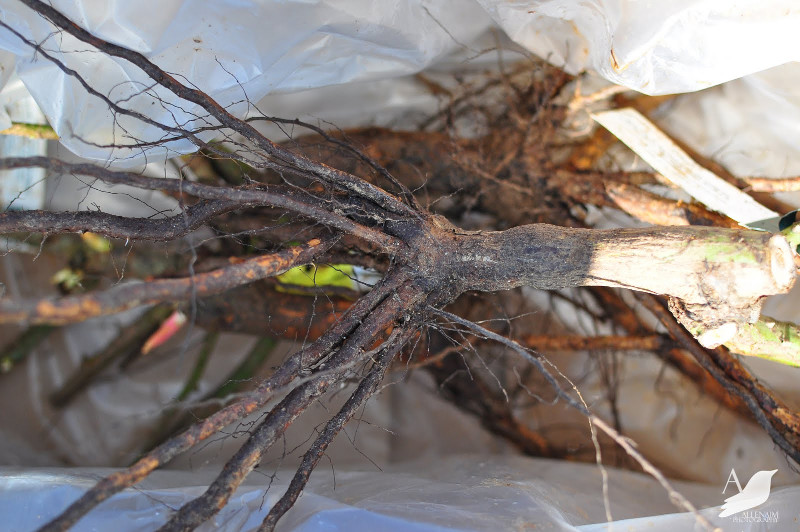
When you first receive the roses, put the roots in a bucket of water to soak the roots.
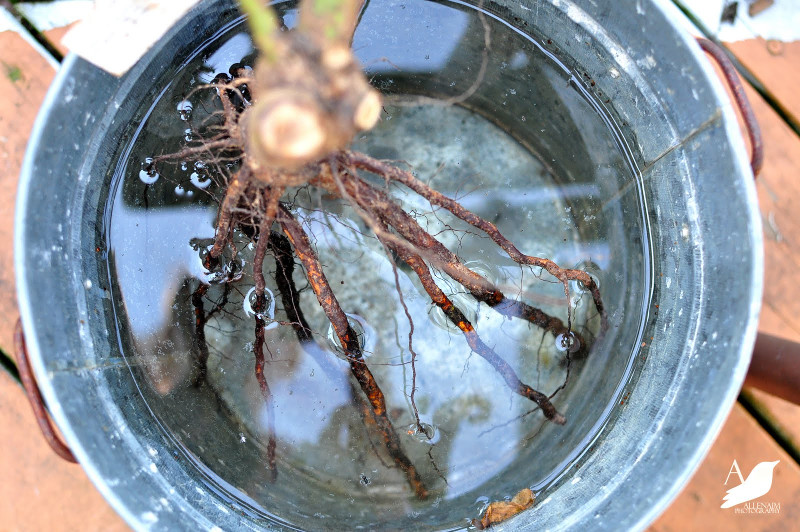
Notice those clean cuts? That's what you want to see!
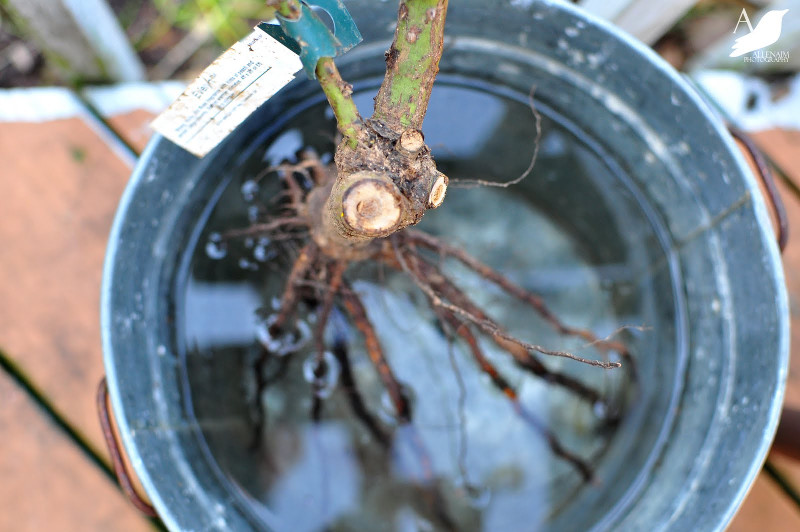
Next dig up a really large hole for the plant. Typically you don't need to dig a hole much larger than the rootball. But for bare root plants, the hole should be much larger so the roots have room without having to crunch them together to fit the plant. Long, deep, wide holes with a mound of dirt in the center. Spread those (perfectly spaced and already trained to spread) roots around the mound of soil. Backfill with soil, and a layer of mulch and the roses are ready to be watered again!
Once the plant is firmly in the ground and you've patted the soil and mulch around the roots. Apply a generous amount of water around the plant, so the water soaks all the way down to the bottom of the roots. This will help encourage the plant to "wake up", and help the plant get established. Apply deep watering applications as often as the ground is dried up about 1-2 inches deep.

We realize that if you aren't a plant person, these plants look like nothing. But give it a few months and you'll be drooling over these luscious roses.
Planting Potted Roses
Step 1 - Thoroughly water the container grown rose.
Step 2 - Dig a hole wide enough and deep enough for the root ball.
Step 3 - Mix compost or fertilizer into the soil.
Step 4 - Remove the rose plant from its pot, loosen the root ball, and spread out the roots.
Step 5 - Place the root ball in the hole so the top of the root ball is ground level.
Step 6 - Refill the hole with soil patting down to remove air holes.
Step 7 - Thoroughly water the shrub.
Step 8 - Add a layer of mulch to retain moisture.
Transplanting Roses
If you find that you need to transplant a rose bush, the best time to do this is when the plant is dormant-- winter or early spring. Transplanting during the growing season will stress out the rose shrub and it will not bloom as well. Begin by cutting the rose canes back 10 to 12 inches and remove any foliage. Dig a new hole where there will be good drainage. Dig out the root ball of the rose far enough away so as not to damage the roots.
You will want to transplant as many of the original roots as possible. Move the root ball to the new hole. Mix equal amounts of potting soil, peat moss, and mulch and fill the hole halfway. Water well and allow the mixture to settle. Add the remaining soil mixture and water again.
Do not fertilize until you see signs of new growth. If you have an unusually large rose shrub, you can split the root ball down the middle and follow the same transplanting procedure for each of the halves.
Roses can be propagated from cuttings. This is referred to as own-root roses. Cut a healthy cane from a rose about 6 inches long. Pinch off all leaves except for a few at the top. Remove the flowers or buds. Fill a clean jar with lukewarm water and place the cutting in the water. Be sure the leaves are not underwater.
Place the jar in indirect sunlight. Rooting the rose will take three to four weeks. Replace the water with fresh water every three to five days. When the roots are 2 to 4 inches long, you can pot the cutting.
When to Plant Roses
The best time to plant roses is in late spring or early summer. If you choose to plant roses in the fall, be sure it is at least six weeks before the first frost. This will give the shrub more time to establish itself before it goes dormant.
Ideally, a cloudy mild day with temperatures between 40 and 60 degrees is optimal planting conditions. This will allow the shrub to get well rooted before the summer heat arrives. Summer planting is not recommended as the high temperatures can stress out the plant.
Bare root roses should be planted in the spring when the plant is fully dormant. You will have more planting flexibility if you purchase potted roses. Container grown roses can be planted at any time.
Plants We Recommend
 |
Author Chris Link - Published 05-28-2021 |
